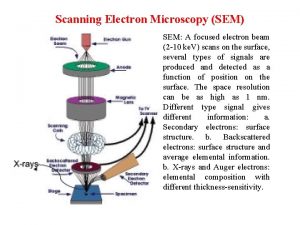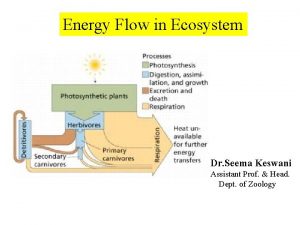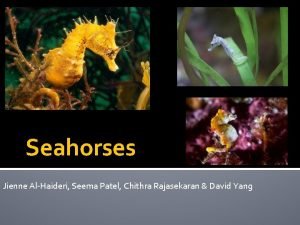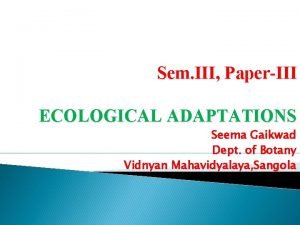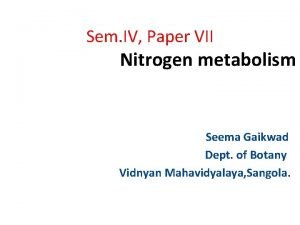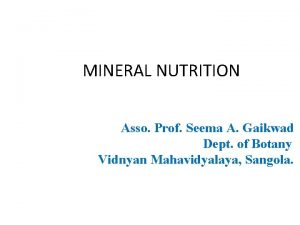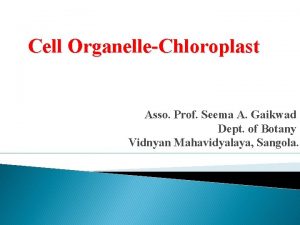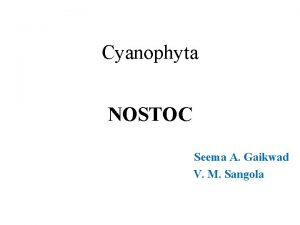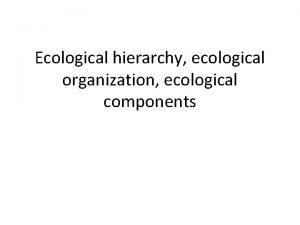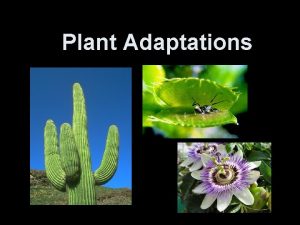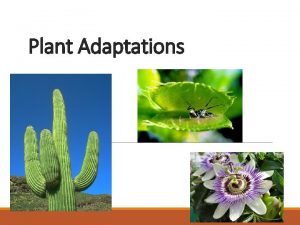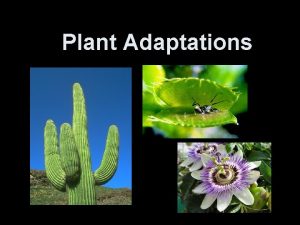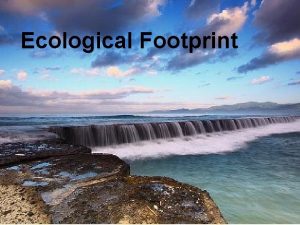Sem III PaperIII ECOLOGICAL ADAPTATIONS Seema Gaikwad Dept






















- Slides: 22

Sem. III, Paper-III ECOLOGICAL ADAPTATIONS Seema Gaikwad Dept. of Botany Vidnyan Mahavidyalaya, Sangola

Introduction � “Any characteristic of an organism or its part which enable it to survive in its own particular habitat is called adaptation”. It is also defined as, “Adaptation is the evolutionary process whereby an organism becomes able to survive and reproduce in its habitat or habitats”. Adaptation is nothing but any changes in the structure or function of an organism or in any parts of its that results from natural selection and by which the organism becomes better fitted to survive and multiply in its environment.

Xeric Adaptations �Water availability in the soil is very low than the requirement of plants. �The temperature is very high so humidity is less which results in the loss of water. �Arid, dry area with low rainfall, � Hot, dry climate is responsible for increasing evaporation and transpiration. �All these environmental conditions are responsible for drought in that habitat.

Drought escaping plants (Ephemerals) - These are also called as drought evaders which have a very short life cycle i. e. they are annuals, to avoid the drought e. g. Tribulus terrestris, Argemone mexicana, Cassia tora etc. Drought tolerant/enduring plants (succulents) - They store large amount of water in different organs of their body, so they become fleshy. They are called succulents. The stem succulents store water in stem so it becomes fleshy, green and photosynthetic leaves are reduced to spines e. g. Opuntia. In leaf succulents store water in leaves and they become thick fleshy as in Aloe, Portulaca. Drought resisting plants (Non- succulents) - These plants are the true xerophytes. They resist the drought by showing external and internal adaptations to dry conditions. Examples are Calotropis, Casuarina, Nerium, Acacia.

Morphological adaptations of xerophytes � Roots: Root system is well developed and profusely branched. � Stem: The stem is hard, woody either aerial or subterranean, sometimes covered with wax. � Leaves: Leaves are thick and leathery, tough, shining (Nerium) or may be thick, fleshy & succulent (Aloe). � Reproduction: In the xerophytes sexual reproduction is common. Some xerophytes reproduce vegetatively and some by dormant buds (Cacti).


Anatomical adaptations of xerophytes � Roots: Root cap is present. Root hairs are large in number. Conducting tissues, i. e. , xylem and phloem, developed very well. Thick cuticle is present which protects internal tissues from dry and hot soils. � Stem: Epidermis is thick walled and lignified. Some plants shows wax deposition on the surface of epidermis and even in the hypodermis. In succulent stems, thin walled parenchymatous cells store excess amount of water, mucilage, latex, etc. called water storage tissues. Woody xerophytes produce very well developed cork in the stem. Mechanical tissues and vascular tissues are well developed.

Leaves: � Epidermis with thick cuticle & epidermal cells are thick walled. � Multilayered epidermis is present on both upper and lower surface of leaves. � Sunken stomata are present and stomatal opening is covered with number of hairs, presence of many layered palisade tissue. � Mesophyll is very compact with reduced intercellular spaces. � In succulent leaves, spongy parenchyma i. e. water storage tissue stores water. � Thick walled sclerenchyma cells are seen in the hypodermis e. g. Pinus needle. � Well developed vascular and mechanical tissues are present.

T. S. of Nerium leaf

Physiological Adaptations of Xerophytes � The stomata of these plants open during night hours and remain closed during the day to prevent water loss by reducing evaporation rate. � The xerophytes have very high osmotic pressure of the cell sap, which increases the turgidity of the cell sap. � These plants control the excessive loss of water during transpiration by reducing total transpiring surface, � Xerophytes have greater potentiality to resist wilting. � The protoplasm in these plants is less viscous and more permeable and resistant to heat. � These plants may secrete resins and waxes (epicuticular wax) on their surfaces, which reduce evaporation.

Hydric Adaptations � Water availability is far more than the requirement of plants. � There is no need of mechanical strengthening as plants are supported by water all around them. � Aquatic plants can only grow partially or completely in water or in soil that is permanently saturated with water. � The habitat of aquatic plants is either fresh water or marine. � Underwater leaves and stems are flexible to move with water currents.

Submerged hydrophytes- Plants are growing under the water surface e. g. Hydrilla, Potamogeton, Utricularia

Floating hydrophytes- Free floating hydrophytes: Freely floats on the water surface, not rooted in the soil e. g. Eichhornia, Pistia. Floating but rooted hydrophytes: Plants are rooted in the soil but leaves are floating on the surface of water e. g. Nymphaea, Marsilea.

Amphibious hydrophytes - These are growing in shallow water or in muddy soil i. e. in marshy places e. g. Cyperus , Typha

Morphological adaptations of Hydrophytes � Roots: Root system of hydrophytes is not of much importance, because they grow partially or completely in water. Roots are poorly developed (e. g. Hydrilla, Vallisneria. ), reduced or completely absent (e. g. Utricularia, Ceratophyllum, ). � Stem: In submerged hydrophytes, the stem is long, slender thin, spongy and flexible e. g. Hydrilla. In free floating hydrophytes, the stem or stolon is horizontal, spongy, thick and short, floating on the surface of water e. g. Eichhornia, Azolla, Pistia while in rooted hydrophytes like Nymphaea, Nelumbium, Cyperus, the stem is a rhi zome.

Morphological adaptations of Hydrophytes Petioles: Some floating hydrophytes show special features in the petioles. In free floating but rooted hydrophytes like Nymphaea and Nelumbium, petioles are long, slender and spongy while they are swollen, spongy in free floating hydrophyte like Eichhornia, helps in floating. � Leaves: In submerged hydrophytes, the leaves are long, narrow e. g. Vallisneria while it is finely dissected e. g. Ceratophyllum. In free floating hydrophytes, leaf lamina is shiny due to the deposition of waxy material, smooth having a spongy and swollen or bulbous petiole which helps in buoyancy while in floating but rooted hydrophytes like Nelumbium and Nymphaea the petioles are long and the lamina are peltate with their lower surfaces in direct contact with water and the upper surfaces exposed to air. Some amphibious hydrophytes show heterophylly (leaf dimorphism), i. e. the presence of two types of leaves �

Morphological adaptations of Hydrophytes �Reproduction: The reproduction is mainly by vegetative propagation. The flowers and seeds are less abundant. Some plants produce seeds that can float. Pollination e. g. Vallisneria and dispersal of fruits and seeds is accomplished by water.

Anatomical adaptations of Hydrophytes Root: � Cuticle is very thin or absent. � Root hairs present in amphibious hydrophytes. � Epidermis is single layered made up of thin walled cells. � Parenchymatous cortex i. e. arenchyma is well developed. It has numerous air chambers which help in buoyancy (floating) and rapid gaseous exchange. � Conducting tissues, i. e. , xylem and phloem, developed poorly and less differentiated. Only xylem tracheids are present in submerged forms while phloem is well differentiated in amphibious hydrophytes. � Mechanical tissues are generally absent. � Pith is absent. Stem: � Cuticle is very thin, poorly developed or absent. � Epidermis is single layered with thin walled parenchymatous cells. � The rhizome of Nymphaea and stem of Typha shows well developed epidermis. � In floating forms, thin walled parenchymatous or collenchymatous hypodermis is present which is containing chloroplasts. � Parenchymatous cortex is well developed with number of air chambers which help in buoyancy (floating) and rapid gaseous exchange. � Endodermis and pericycle is generally distinct. � The vascular tissues, i. e. , xylem and phloem, developed poorly, thin walled except in amphibious hydrophytes. � Mechanical tissues are poorly developed or absent.

Anatomical adaptations of Hydrophytes- Hydrilla stem T. S.

Leaves: is absent or poorly developed in Nymphaea leaves. � Epidermis is single layered with thin walled parenchymatous cells. � Chlorophyll found in all the tissues. Epidermal cells of leaves contain abundant chloroplasts and they can function as photosynthetic tissue, especially where the leaves and stems are very thin e. g. Hydrilla. � Stomata are totally absent in submerged plants, but in floating leaves, stomata are present on the upper surface. In amphibious plants stomata may be scattered on all the aerial parts. � In submerged plants, mesophyll tissues are not differentiated while in other forms of hydrophytes these are well differentiated into spongy parenchyma and palisade tissues. They show air cavities. � In submerged leaves, air chambers are filled with respiratory and other gases. � Mucilage canals and mucilage cells are present which secrete mucilage to protect the plant body. � Mechanical tissues are poorly developed or completely absent. � Cuticle

Physiological Adaptations of Hydrophytes � Osmotic concentrations of cell sap are low. � Entire plant surface absorb water and nutrients. � Hydrophytes maintain active photosynthesis as chloroplasts are distributed throughout the plant body. � CO 2 and O 2 evolved during respiration and photosynthesis is stored in air chambers for future use. � No transpiration from submerged plants.

Thank You
 Sem sem sem
Sem sem sem Releia voltou a criar histórias
Releia voltou a criar histórias Peixinho sem agua floresta sem mata
Peixinho sem agua floresta sem mata Dr seema mehrotra
Dr seema mehrotra Seema munaf
Seema munaf Seema wadhwa
Seema wadhwa Seema keswani
Seema keswani Seema patel md
Seema patel md Dr seema mehrotra
Dr seema mehrotra Mistress seema rani
Mistress seema rani Seema arora cii
Seema arora cii Dr seema haque
Dr seema haque East of england deanery
East of england deanery Identify
Identify Hamlet act iii scene ii
Hamlet act iii scene ii Rowan county dss child protective services
Rowan county dss child protective services Lafd interview score
Lafd interview score Gome dept
Gome dept Department of finance and administration
Department of finance and administration Oxford dept of continuing education
Oxford dept of continuing education Nys dept of homeland security
Nys dept of homeland security Florida dept of agriculture and consumer services
Florida dept of agriculture and consumer services Vaginal dept
Vaginal dept
